Truth was a newspaper published in Sydney, Australia. It was founded in August 1890 by William Nicholas Willis and its first editor was Adolphus Taylor. In 1891 it claimed to be "The organ of radical democracy and Australian National Independence" and advocated "a republican Commonwealth created by the will of the whole people", but from its early days it was mainly a scandal sheet. Subsequent owners included Adolphus Taylor, Paddy Crick and John Norton.

The Sydney Mail was an Australian magazine published weekly in Sydney. It was the weekly edition of The Sydney Morning Herald newspaper and ran from 1860 to 1938.

Alfred Quill was an Australian soccer player and played for the Australia national team. Often considered one of the best soccer players in New South Wales, he scored 868 goals in all NSW competitions in his 24-year senior career.
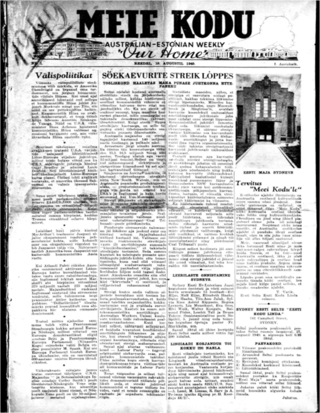
Meie Kodu is an Estonian language newspaper published in Sydney, New South Wales, Australia, from 1949.
Gundagai lore is associated with Gundagai, Australia, a place of considerable reputed Aboriginal cultural significance, with both archaeological sites and anthropological associations related to sacred and spiritual beliefs of the local clan group and wider cultural associations.

Bell's Life in Sydney and Sporting Reviewer, also published as Bell’s Life in Sydney and Sporting Chronicle, was a weekly English language newspaper published in Sydney, New South Wales, Australia between 1845 and 1870.

The Liverpool Herald, earlier published as The Liverpool Mercury and The Liverpool Times, was a weekly English language newspaper published in Liverpool, New South Wales, Australia from 1897 to 1907 and is an important resource to the history of the local area of Liverpool. The issues of the ten-year period covered the daily events of the then country-town Liverpool as well as providing commentaries on events overseas at the time. They also represent the only existing detailed record of any type from that period.

Australian Town and Country Journal was a weekly English language broadsheet newspaper published in Sydney, New South Wales, from 1870 to 1919. The paper was founded by Samuel Bennett with his intention for it to be "valuable to everybody for its great amount of useful and reliable information".
The Goulburn Chronicle and Southern Advertiser was a weekly English language newspaper published in Goulburn, New South Wales from 1855–1864.
The Blue Mountains Advertiser was a weekly English language newspaper published in Katoomba, New South Wales, Australia.
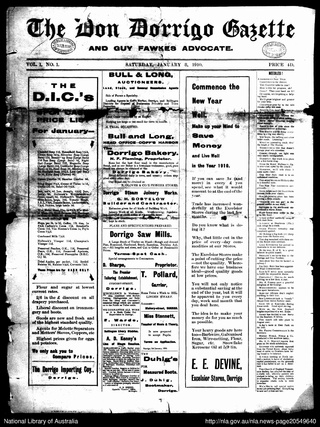
The Don Dorrigo Gazette, previously published as the Don Dorrigo Gazette and Guy Fawkes Advocate, is a weekly English language newspaper published in Dorrigo, New South Wales, Australia.
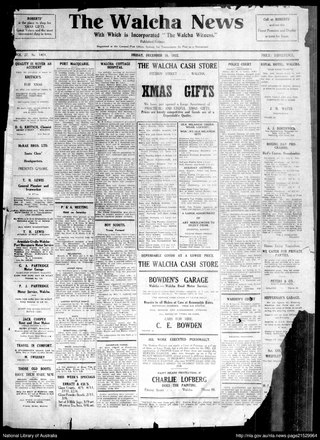
The Walcha News, originally published as The Walcha News and Southern New England Advocate, is an English language newspaper published in Walcha, New South Wales.
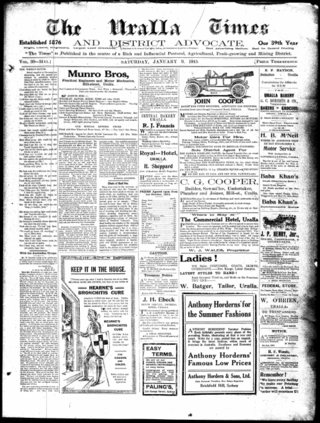
The Uralla Times was a newspaper published under various titles between 1895 and 1983 for the town of Uralla, New South Wales, Australia.

The Moree Champion, previously published as the North West Champion, is a bi-weekly English language newspaper published in the Shire of Moree, New South Wales, Australia. The newspaper was first published in 1912. It is published each Tuesday and Thursday and is distributed throughout the north west region of New South Wales.
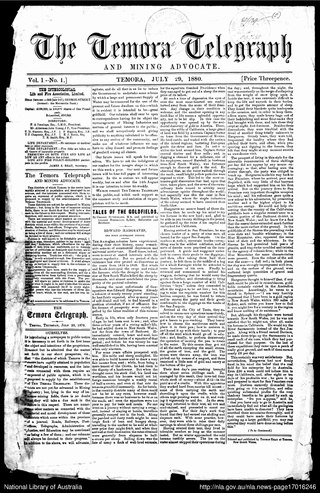
The Temora Telegraph and Mining Advocate was an English language newspaper published in Temora, New South Wales, Australia.

The Manning River Times, also published as The Manning River Times and Advocate for the Northern Coast Districts of New South Wales, is a twice weekly English language newspaper published in Taree, New South Wales, Australia.
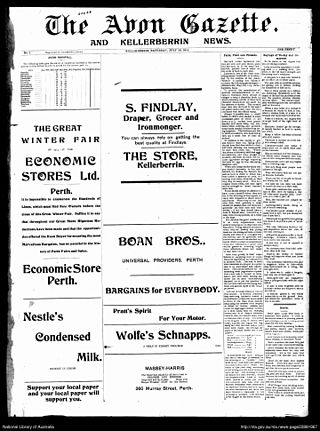
The Avon Gazette and York Times is a defunct English language newspaper that was published weekly in York, Western Australia. The newspaper was first published as The Avon Gazette and Kellerberrin News between 10 July 1914 and 8 January 1916.

The Beverley Times is a defunct English language newspaper that was published weekly in the Wheatbelt town of Beverley, Western Australia, between 1905 and 1977.
James Harold Flower (1907–1979) was an Australian rugby league footballer who played in the 1930s. Jim 'Pansy' Flower was the brother of Harry Flower who was also a St. George first grade player and NSW rep.

Hermann Rieck was a pioneer farmer in the Coffs Harbour region of New South Wales, Australia, and the founder of the banana industry in the region.


















